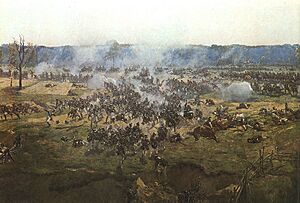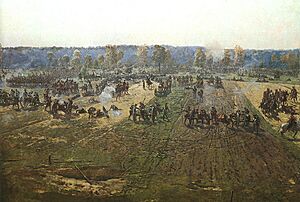Bagration flèches facts for kids
The Bagration flèches (pronounced "flesh-ez") were three important military forts made of earth. They were named after General Pyotr Bagration, who ordered them to be built. These forts were key strongholds for the Russian forces. They played a huge role in the Battle of Borodino on September 7, 1812.
The flèches were located southwest of the village of Semyonovskoye. They included two "lunettes" (V-shaped forts) and one "redan" (a small, triangular fort). During the battle, both the French and Russian armies attacked these forts eight times.
Russian soldiers and local volunteers built the flèches. Their goal was to give Russian cannons a good position to fire at the French army from the front and the side. Hundreds of men from each division helped with the construction. The forts were finished on August 25, 1812 (according to the Russian calendar).
The Attacks Begin
The Bagration flèches were defended by Russian artillery units. The left fort had twelve cannons, the middle one had seven, and the right one had five. Each fort also had a battalion of soldiers. In total, 28 cannons were placed near the flèches.
On September 7, 1812, around 6 AM, Napoleon began the attack on the flèches. Two French infantry divisions, led by Joseph Marie, Count Dessaix and Jean Dominique Compans, attacked directly. They were supported by 102 cannons. The first attack was stopped by heavy fire from the Russian cannons and infantry.
Second Attack
For the second attack, the French moved their cannons closer. They also brought in more soldiers and cavalry. Around 7 AM, Compans' troops managed to break into the left flèche. However, Russian infantry, supported by cavalry units like the Akhtyr hussars and Novorossiyan dragoons, pushed them back. During this fight, several French generals were hurt. Louis-Nicolas Davout even got a head injury when his horse was killed.
Third and Fourth Attacks
Before the third attack, Russian General Aleksandr Tuchkov sent more soldiers to help. Around 8 AM, after a lot of cannon fire, the French attacked again. Some of their soldiers were wiped out by "canister shot" (a type of cannonball filled with small metal balls). Compans' infantry took the left flèche again, and other French troops rushed into the areas between the forts. But Russian soldiers fought back with bayonets and pushed the French out.
Around 9 AM, Napoleon ordered a fourth attack. The French managed to take the flèches about an hour later. But once again, they were quickly forced to leave.
Later Attacks and Heavy Losses
During the fifth attempt, around 11 AM, the French took the right and left forts. Sadly, General Tuchkov was killed in this attack. However, another Russian division managed to counter-attack and push the French back again.
The French also tried to get behind the forts through a nearby forest, but this attempt failed.
After gathering their forces, French infantry tried to attack the defenders from behind. But they were quickly defeated. Frontal attacks by French generals Ney and Davout were also stopped.
The seventh attack was also unsuccessful for the French. Russian infantry regiments from Brest, Ryazan, Minsk, and Kremenchug bravely defended the forts. Ney's and Davout's attacks were pushed back once more.
The final attack was incredibly strong. The Russian cannons could not stop the French soldiers this time. General Bagration ordered his infantry to counter-attack immediately. The fighting was very fierce and lasted about an hour. General Bagration was hit by shell fragments while leading the counter-attack and had to leave the battlefield.
Out of 60,000 French soldiers who attacked the flèches, about 30,000 were lost. This terrible loss of life led historians to call the battle for the flèches the "grave of the French infantry." It was one of the deadliest battles ever recorded, with about half of the soldiers on the field becoming casualties.



